Water demand is the amount of water required to fulfill the demand of the consumers.
✔ It depends on the size of the city, quality of water, metering system, pressure in the pipeline, etc.
✔ It is necessary to determine the quantity of water required before designing a water supply scheme. The first step is to determine the demand for the town, village, etc, and to find suitable sources of water from which water demand should meet.

1. Types of Water Demand
Seven types of water demand are :
a. Domestic Demand
The quantity of water required in the houses for drinking, bathing, cooking, toilet flushing, gardening, individual air-conditioning, etc is called domestic demand.
For designing purpose in developing countries, we use the data as follow:
By public tap / No private connection – 45 lpcd( liters per capita per day)
For partially plumbed house – 65 lpcd(liters per capita per day)
For fully plumbed houses – 110 lpcd(liters per capita per day)
In developed countries like the USA, UK, Australia, etc; about 300 liters per capita per day is usually taken.
| Read Also: Filter Numerical Questions Slow & Rapid sand Filter Water Supply Engineering |
b. Livestock Demand
The quantity of water required for the domestic animal is known as livestock demand.
Where livestock demand is not considered?
Livestock demand is not considered in the urban area but we considered it in rural areas as livestock is an important component of the rural economy.
” Livestock demand must be more than 20% of the designed domestic demand.”
For Big Animals -cows, buffalo, horse – 45 L/(animal day)
For Medium Animals – sheep, goat – 20 L/(animal day)
For Birds- parrots, ducks, hens – 20 L/ (100 bird day)
c. Commercial and Institutional Demand
It includes the demand for offices, stores, schools, hospitals, theatres, etc.
a. Educational Institution
Day School – 10 lpcd(liters per capita per day)
Hostels – 65 lpcd( liters per capita per day)
b. Hospital
With Bed – 500 liters per bed per day
Without Bed- 2500 liters per day
c. Hotel
With Bed – 200 liters per bed per day
Without Bed – 500-1500 liters per day
d. Restaurants / Tea Stalls
500 – 1000 liter/day
e. Offices
500 – 1000 liter/office/day
d. Industry Demand
It is commonly considered in urban areas. The quantity of water required for the various industries is known as industry demand. Normally 20-25% of total demand is taken as industry demand.
e. Demand for public places or Municipal demand
It includes water required for washing and sprinkling on road, cleaning sewers, watering public parks, etc. Normally 5% to 10 % of total demand is taken as municipal demand for public places.
f. Fire Demand
During the breakout of the fire, water is used for fire fighting is called fire demand.
1 % of total demand is considered for fire demand.
g. Losses and Wastes
Water losses and waste may be because by the following:
a. Leakage and overflow from service reservoirs.
b. Losses due to the defective pipe.
c. Losses that are due to the unauthorized or illegal connection.
d. Losses from the consumer when they keep on taps of public tap stand even when they are not using the water.
e. About 15% of total water demand is taken to compensate for losses, theft, and waste of water.
| Read Also: Water-Related Diseases |
2. Factors Affecting Water Demand
a. Size of town or city
Water demand increases with an increase in the size of the town or city.
An extra amount of water is required for streets cleaning, gardening, flushing, etc. This increases the water demand.
b. Living Standard
The consumption of rate of water directly depends upon the economic status of the consumer.
Upper-class(Rich) consumers use more water than lower-class ( Poor) consumers.
c. Climatic Condition
Water demand is more in hot weather than in cold.
During hot weather; the loss of water from the human body is more in the form of sweat which makes people more thirsty and requires more water for balancing the body. So water consumption increases causing an increase in water demand.
d. Industrial And Commercial Activities
Industrial and commercial activities increase the rate of water demand.
e. Quality of Water
As the quality of water increases, the rate of consumption and use of water by the consumer also increases.
Simply, good quality water leads to an increase in demand for water.
f. System of Water Supply
Water may be supplied intermittently (i.e. for a limited time during certain fixed hours of the day) or continuously for all 24 hours of the day.
The rate of water demand is low in the intermittent system of water supply.
g. Metering System
The rate of water demand is more in the non-metered system than in the metered system.
In the metered system, the bill of the water increases with an increase in water use. This limits the demand for water from increasing.
h. System of Sanitation
The presence of the sewerage system increases the rate of water demand.
The residents of the town or city will also be required more water for sanitary units such as closets, drainage, etc.
i. Cost of Water
When the cost of water increases, demand decreases, and vice versa.
j. Age of Community
Water demand is high in newly constructed cities.
More water is required for the construction of infrastructures, plantations, etc.
k. Pressure In Pipeline
The demand for water increases with an increase in pressure in the pipeline.
| Read More: Water Distribution System |


